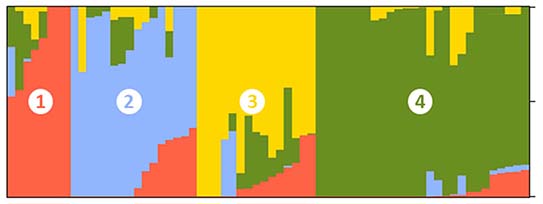GRAPEVINE ROOTSTOCKS: CHARACTERIZED FOR THE FIRST TIME THE LARGE BIODIVERSITY
Grapevine (Vitis vinifera L.) is grafted on rootstocks belonging to non-vinifera species, as they are resistant to the phylloxera attack (Daktulosphaira vitifoliae Fitch). DiSAA can boast one of the largest collections of grapevine rootstocks worldwide (232 genotypes). This collection, genetically characterized with microsatellite markers, has been used to sort out a core collection of genotypes, being the starting point for future breeding programs. The core collection, accounting for 70 genotypes, was analyzed with a new and promising genetic analysis tool, called Vitis18kSNP. It is a chip able to return the result of 18000 SNP (Single Nucleotide Polymorphism) loci in one run. The analysis highlighted a high degree of heterogeneity of the genotypes analyzed, supporting the complex genetic background characterizing the non-vinifera germplasm, and clearly differentiated the V. vinifera and non-vinifera genotypes.

Figure: genetic structure of grapevine rootstocks core collection (A) and differentiation of V. vinifera and non-vinifera germplasm(B).
REFERENCE
Bianchi, D.; Brancadoro, L.; De Lorenzis, G. Genetic Diversity and Population Structure in a Vitis spp. Core Collection Investigated by SNP Markers. Diversity 2020, 12, 103 [doi: https://doi.org/10.3390/d12030103].
NOTES
The APC was funded by University of Milan.
This work is part of the European project titled “FREECLIMB—Fruit Crops Adaptation To Climate Change In The Mediterranean Basin” in the frame of the Programme Partnership For Research And Innovation In The Mediterranean Area (PRIMA; call 2018).

